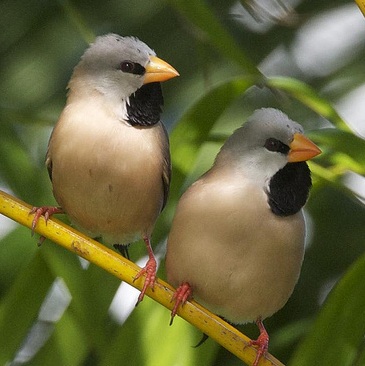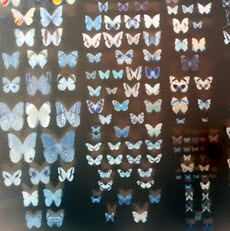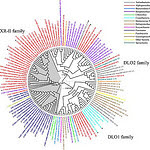Topic 5 - Evolution revision list
This pages gives outline details of the content of the topic together with essential questions and student skills and applications. Helpful for revision.
5.1 Evidence for evolution
- A change in the heritable characteristics of a species is evolution.
- Evidence for evolution comes from
- the fossil record.
- Selective breeding of domesticated animals
- "Adaptive radiation" can explain similar structures with different functions.
- Isolated populations can produce separate species by divergent evolution.
- Continuous variation across the geographical range of related populations matches the concept of gradual divergence.
Essential Questions 
- What is evolution?
- What evidence is there to support evolution?
- How can evolution explain the appearance of organisms / populations?
Skills (can you ....)
- Describe how the dark bark leads to the development of melanistic insects in polluted areas.
- Compare and contrast the pentadactyl limb of mammals, birds, amphibians and reptiles.
- Describe how each limb structure is adapted to each different method of locomotion.
5.2 Natural selection
- Natural selection requires;
- variation in adaptations within a species.
- overproduction of offspring
- best adapted individuals have better survival rates
- so they reproduce more and pass on successful adaptations to offspring.
- Variation within a species can be caused by Mutation, meiosis and sexual reproduction.
- Adaptations are advantageous characteristics of an individual for it's way of life.
- More offspring are produced by the best adapted individuals while less well adapted individuals die or produce fewer offspring.
- Adaptations / characteristics are passed on to offspring (inheritance).
- Natural selection increases the frequency of the better adaptations and decreases the frequency of other characteristics. This leads to changes in characteristics within the species
Essential Question(s) 
- How does natural selection cause evolution?
- Why do members of the same species have such variation in their characteristics?
- Do the characteristics of individuals or the average characteristics of populations change due to evolution? (Students should be clear that characteristics acquired during the lifetime of an individual are not heritable.)
Skills (can you ....)
- Analyse data about the changes in beak lengths of finches on Daphne Major.
- Understood how the evolution of antibiotic resistance in bacteria occurs by natural selection.
5.3 Classification of biodiversity
- The binomial system of scientific names is used across the world. It was agreed by biologists at a series of congresses,
- When a species is discovered it is given a scientific (binomial) name.
- Taxonomists classify species using a hierarchy of taxa.
- All organisms are classified into three domains; Archaea (called archaeans), eubacteria (bacteria) and eukaryote (eukayotes). (Viruses are not classified as living)
- Eukaryotes are classified into the main taxa: kingdom, phylum, class, order, family, genus and species.
- In a natural classification, the genus and accompanying higher taxa consist of all the species that have evolved from one common ancestral species.
- This natural classification helps identification of species and the prediction of shared characteristics by related species.
- Taxonomists sometimes reclassify groups of species when new evidence about evolution appears.
Essential Question(s) 
- How do binomial system names help scientists to collaborate across the world?
- How are living organisms classified? Into what groups?
- What are the benefits of classifying living things?
- What happens if an organism is badly classified.
Skills (can you ....)
-
Classify one plant and one animal species from domain to species level.
-
Remember and recognise the main features of:
-
bryophyta, filicinophyta, coniferophyta and angiospermophyta.(including vascular tissue
-
porifera, cnidaria, platylhelmintha, annelida, mollusca, arthropoda and chordata.
-
birds, mammals, amphibians, reptiles and fish.
-
-
-
Construct a dichotomous key for use in identifying specimens.
5.4 Cladistics
- A clade is a group of organisms that have evolved from a common ancestor.
- Evidence for species of a clade can be
- the base sequences of a gene or
- the amino acid sequence of a protein.
- There is a gradual accumulation of differences and a positive correlation between the number of differences between two species and the time since they diverged from a common ancestor.
- Cladograms are tree diagrams that show the most probable sequence of divergence in clades.
- Evidence from cladistics has shown that classifications of some groups based on structure did not correspond with the evolutionary origins of a group or species.
- Traits can be analogous (due to convergent evolution) or homologous (inherited from a common ancestor).
Essential Question(s) 
- Which features can we use to arrange species into "family trees" of related species?
- How does the modern ability to analyse the DNA sequence of a whole organism help to group species?
- Can you give any examples of how classification of organisms has changed in the light of evidence from cladistics?
- Why are fore-limbs (with 5 fingers) thought to be homologous structures, but the wings of a pterodactyl and bat wings are considered analogous - similar structures which developed independently?
Skills (can you ....)
-
Interpret and deduce relationships from cladograms including humans and other primates.
-
Appreciate that in the light of new evidence some cladograms are changed.
-
For example the reclassification of the figwort family using evidence from cladistics.

 IB Docs (2) Team
IB Docs (2) Team
